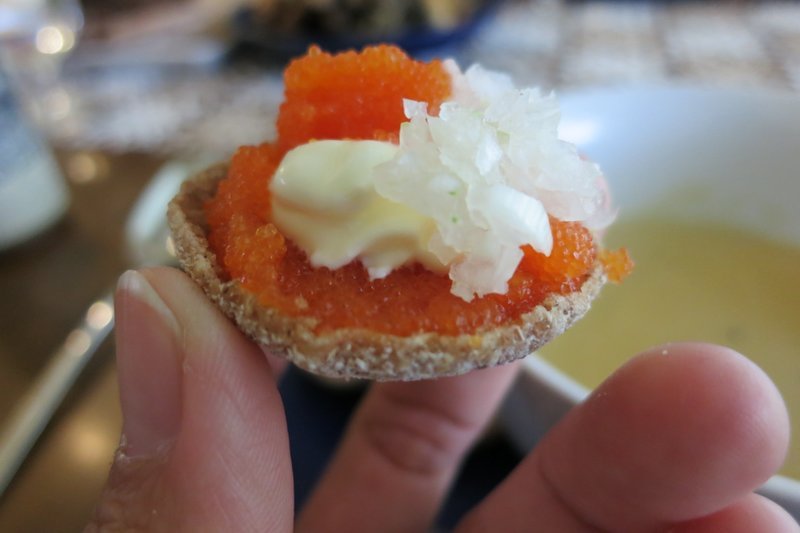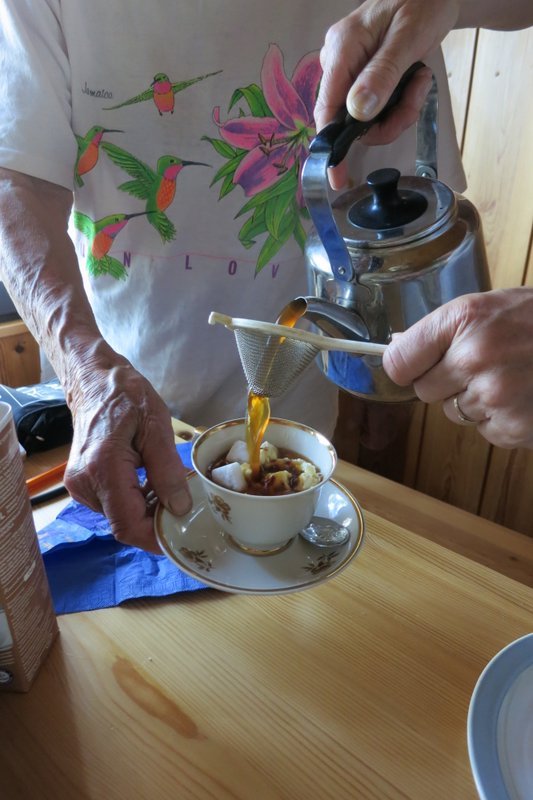Finnish Your Plate
Blog post #4 From The Finland Trip
My Finnish-American grandmother was very fond of lutefisk as was her mother before her. But the jellified lye-soaked cod dish is not traditionally Finnish. They picked up the habit from Norwegians in northern Wisconsin or Upper Peninsula Michigan, I suppose. But other than some juustoleipä – Finnish “squeaky cheese” – which I found being made in Wisconsin, I really had no ideas about Finnish cuisine. So the entire trip was a series of little surprises. My cousin Irene warned me: “We are a meat and potatoes culture.” I assured her: so is Wisconsin. Between dining out and eating in we enjoyed a great snapshot of the Finnish table during our Finland trip.
Elk (Moose)

Like Wisconsin, Finland also enjoys meat from outside the usual beef/pork/chicken sphere. Irene and her husband – I knew from past emails, and soon from sitting at their dining table in their home in Lapland inside the Arctic Circle – were elk hunters. In Wisconsin, deer hunting season is practically a state holiday and a few of the more rural schools even close for that week as a “fall holiday” knowing attendance would likely be low anyway. I grew up with abundant venison in the freezer and while I never got into hunting, I took a hunter safety course when I was 12 which would allow me to hunt without supervision when I was 14. (Actually, I noticed a typo on that old certificate that added a year to my age, so my DNR Hunter Safety Certificate was inadvertently my first and only fake ID.)
Irene lives in a small village 120 miles north of Kuusamo. While Kuusamo often considers itself Lapland, it is not quite, and as Irene drove us north we soon crossed the Arctic Circle. Irene keeps hunting dogs and they venture out into the wild annually to restock on elk meat. The cured elk we had at her house tasted almost like ham and had a similar tenderness and texture. Later on in our journey, as Irene drove us farther north into the Arctic Circle we passed an animal-crossing sign. The silhouette was unmistakably a moose to my eyes. I asked Irene if they had moose and she said no, that was an elk crossing sign. We have elk in Wisconsin, and I had no doubt about what I saw. Neither did Irene. So what gives? I googled and it turns out that what North Americans refer to as a moose is called an elk in Europe. I had no idea the animal existed outside of Canada and the northern fringes of the United States. What Americans call an elk is just a big species of deer to them. You can get farm-raised elk burgers in Wisconsin (the elk population is still too small to be hunted), but no moose is on the menu yet – though they make the occasional appearance up north — or even not that far north.
Reindeer

I remember as a child when my grandmother returned from Finland with stories. At one point they had eaten reindeer-blood pancakes. This really blew my mind. On the one hand, reindeer actually existed? Cool! On the other hand, blood in a pancake didn’t sound too appetizing. But indeed reindeer is a common dinner item, and in Lapland, the Sami people still make a living reindeer herding – although their former nomadic life faded away over the generations with the establishment of international borders. In Finland, these herders have vast areas of wilderness divided into zones, and their herds are allowed to wander freely throughout. Each animal is marked with a collar. When we stayed at Aurora Holidays, owner Tiina Salonen, whose husband is a Sami reindeer herdsman, explained the practice. The animals wander, free-range, throughout the winter eating from the natural environment, dining on lichens when the food starts getting scarce, and then returning to the herders when the herders lay out hay bales. This is when the culling occurs. The young reindeer follow their mothers back to the herders and are then tagged with the collars and a cut to the ear.

My cousin Irene prepared a traditional reindeer dish, cooking small strips of meat in butter or oil, then serving them over mashed potatoes with a lingonberry sauce. In the old days, people would set up teepees, hang a pot over a fire, throw in some lard, and cook elk or reindeer meat shaved off a block of frozen meat. We also ate cured varieties of reindeer meat and reindeer jerky, and finally amazing grilled steaks during our stay at Aurora Holidays.
You can also find reindeer on pizza. Italy’s former prime minister Silvio Berlusconi publicly referred to Finnish food as “marinated reindeer” cuisine. In a swift response, Finn pizza chain Kotipizza rolled out the Berlusconi: a pie topped with red onions, chanterelle mushrooms, and, naturally, smoked reindeer. The pizza went on to win the America’s Plate International pizza contest in New York in 2008. Various other pizza restaurants serve some version of a reindeer pizza.
Sausage

The Finns do enjoy their sausages, though we found them a bit mild, something on the order of ring bologna generally. But they are perfect for the grill outs, or even saunas (upcoming post about that). Just be sure to pack a tube in your picnic basket. That’s not toothpaste or glue, it’s the standard packaging for mustard and you don’t leave home without it.
To the Deli!

At the very beginning of our trip, we spent one night in Helsinki – using AirBNB – waiting for the flight to Kuusamo, and our first stop was the famous Stockmann department store, the oldest of its kind in Finland, dating back to 1930. The building’s small clock, which dangles over the main entrance, is the traditional meeting place in Helsinki. “Meet under the clock at Stockmann.” We bought bits of Finnish cheese and some pastries there and when we returned to Helsinki at the end of the Finland trip, we met Heather Domeney of Heather’s Helsinki for one of her great walking tours – a food tour of the city. Heather’s tour also starts with the deli and we learned about the food scene in Helsinki.
Porridge

The word isn’t sexy, ranking perhaps somewhere above ‘gruel’ in the food lexicon. But in Finland it can come with a variety of options. On the Heather’s Helsinki tour, we stopped at Cafe Kuppi ja Muffini specializing in the underappreciated breakfast dish. A toppings bar offered an assortment of flavor enhancements: maple syrup, granola, varied jams, lingonberry sauce, cinnamon, cardamom, almonds. Throw in a cup of coffee and this will carry you to lunch for sure.
Baked Goods

The Karelian pasty is a staple at the bakeries: A flat rye pastry with a cooked rice filling — sometimes flavored with meat or fruit, and often with melted butter. Donuts (munkki) and coffee are common. (more on coffee in another post!) A popular plump sugar donut with jelly inside and four little bumps for “legs” is called possumunkki – piggy donut. Desserts often incorporate the bounty of the forest – wild berries such as bilberry/blueberry, lingonberry, and the unusual cloudberry. Cardamom is a typical seasoning in baked goods, including donuts. Breads tend to be heavy and rye varieties. Finally, Irene made us a batch of fried, thin pancakes, which are called lätty.

In Helsinki you can get some great desserts at Karl Fazer Café, a name famous for Fazer Chocolate (stock up before your flight home). One of the specialty chocolate bars contained bits of popcorn. Curiosity led us to purchase one of the popcorn-chocolate bars, which we gobbled up on the ferry to Tallinn, Latvia (another upcoming post). Weird idea but delicious.
Salmon, Herring and Seafood

We were surprised to find an abundance of bright red crayfish at the supermarket in August. Adopting a tradition from Sweden, the Finns boil them in saltwater and serve them with dill at crayfish parties toward the end of summer. But the most popular seafood is salmon. Whatever you try, the salmon soup is a must. Cream and potato-based and served maybe with rye crackers. We had a bowl at an outdoor vendor at the waterfront market in Helsinki. Salmon also comes cured, salted, cold-smoked, and grilled, of course.

A great appetizer is salmon roe, with sour cream and chopped onion on a rye cracker. We had our fill, especially at Cousin Tanja and Markku’s house for the first family meal in Kuusamo, where we also got to try something Grandma Eva ate a lot of in Wisconsin. When she passed away, my father gave me several very large glass jars we figured would be great for storing things such as flour. They have wide metal lids which revealed the past of the label-less jars: pickled herring.

Clearly, Eva ate a LOT of it, and there it was, two different varieties of pickled herring at the dinner table – albeit not in two-gallon jars.

As I wrote previously, Great Aunt Hilma, like my grandmother, loves to fish. A common catch on the lakes around Teeriranta is muikku (needlefish), which are netted in abundance. Typically they are fried and eaten whole like smelt (Wisconsin loves smelt) or sardines. At Hilma’s place we were offered a cold plate of them, and I shivered at the thought of a cold piece of fried fish. Yet I still managed to eat about a dozen of them using alternating hands. Love.
Cheese

At the Stockmann deli, the Wisconsin guy immediately found the cheesemonger, a fellow who was quite passionate about the trade and liberal with the samples. Artisan cheese in Finland is quite nice, though the styles tend to be from elsewhere – Muenster, Gouda, Cheddar – with the exception of Juustoleipä, what translates as bread cheese. My grandmother said her mother used to make it in a pan in the wood-fired oven and used fresh milk from the family cow. It’s a dense cheese and can hold its form when fried in a pan to get a golden skin on it.

My grandmother only mentioned this cheese a few years ago when I asked about it after discovering it being made locally and for sale at Madison’s famous farmer’s market. She told me they used to dip the cheese in their hot coffee so that the squeak would return to the cheese. We had the chance to try it this way with Grandma’s cousin Hilma, the feisty 85-year-old mother of Irene.
Alcohol

Craft beers in Finland are just coming around. The best craft brews I had were generally stouts and porters, some of them smoked. The mass market beers are light lagers, “sauna beer” might be a good equivalent to the term “lawnmower beer.” But one traditional brew you can find is sahti.

It’s an acquired taste and rather sweet, made with juniper in addition to the grains which may be a mix of rye, oats, and malted barley. Carbonation is minimal. We tried some on Heather’s Helsinki tour along with other craft beers at Bryggeri Helsinki, located between Helsinki’s Cathedral and the waterfront market.

Gin and vodka are popular, and liqueurs include the local berries (cloudberry, for example) and an odd salty black licorice flavor, associated with a candy Finns grew up with. Which brings us to…
Salmiakki

This is an acquired taste. And I didn’t acquire it. Salmiakki is salty black licorice and is easy to find in standard licorice rope form, but also as candies and lozenges. There is a liqueur, which actually wasn’t too bad, and surely the more you drink, the easier it will go down. But then there are other drinks, flavored soda water, and even potato chips. We didn’t pack any salmiakki chips for the journey home.
See more from our Finland Trip




 ORDER YOUR COPY TODAY!
ORDER YOUR COPY TODAY! ORDER YOUR COPY TODAY!
ORDER YOUR COPY TODAY!